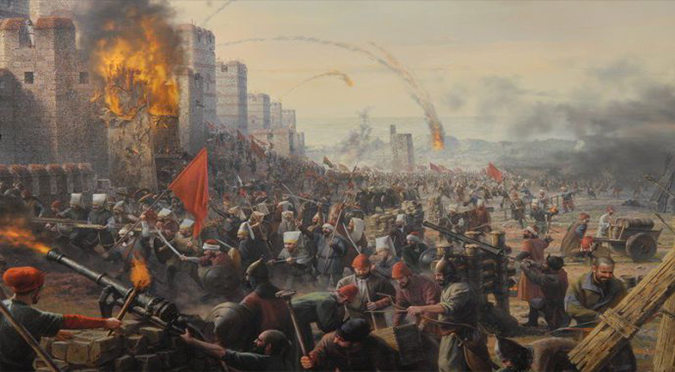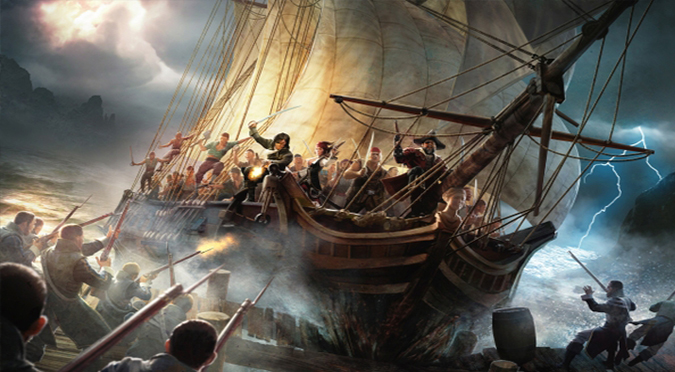
THE FALL OF CONSTANTINOPLE
August 29, 2014
Update!
December 14, 2014The Golden Age of Piracy: 1650-1740

Avast ye land lubbers! Feast yer eyes on this terrible tale o’ woe: an age where we pirates sailed the seven seas in search of our booty and beauties… Aye, tis true we be a pack of scurvy bilgerats, but above all else, we fought fer freedom from tyranny! Alas we failed and were marched to the gallows ta feed the fish… but make no mistake – dead men Do tell tales…
Pirates have technically been around since Ancient Greece, but it’s the notorious Pirates of the 17th and 18th centuries that captured the cultural imagination with their theatricality and legends, which still have a lasting impact today. These pirates spawned a new breed of organized crime, following in the spirit of the Vikings before them, and influencing the mafia that followed. At the height of the “Golden Age” of Piracy, the real life Pirates of the Caribbean relentlessly terrorized the trade routes of the Americas. They were the anti-establishment movement of the early 1700’s. Unlike the typical Hollywood swashbuckling buccaneer with a peg leg, hook for a hand, and parrot pal on the shoulder, the real deal were by no means eyeliner-wearing cosplayers.

Which brings me to…
PIRATE MYTHS

According to some historians, the ‘Jolly Roger’ Skull and Bones symbol on the black and ominous pirate flag (as seen in every single incarnation of pirate-related paraphernalia ever) presumably means… “The Happy Rapist”?! Something to think about that the next time you give candy to a kid dressed like that. That said, the stereotypical pirate flag as we know it isn’t entirely accurate. Most pirates of the time hoisted either a plain red or black flag. The Black Flag actually meant surrender or else, however it was the Blood Red Flag that one needed to be concerned with, that was the symbol that no quarter would be given.
The typical pirate ship was actually one of the best examples of a true democracy. The real Pirates of the Caribbean followed the Code of the Brethren, which emphasized equal share among plunder and the concept of parlay, even the Captain could be voted out by his crew. For a ship load of greedy, murderous bastards, Pirates were also very progressive in some respects: they had healthcare, and didn’t care about gender, sexuality, or religious beliefs.
 Another key token of the Pirate myth: Treasure maps are pure fiction, because it wasn’t exactly common for pirates to abandon perfectly good loot in a sand dune. Although Pirates did love their gold as much as the next scoundrel, more often than not when they looted vessels it was for more essential things, like medicine and food. After all, historical sources suggest they didn’t have CVS or Arrrrrrby’s on the high seas.
Another key token of the Pirate myth: Treasure maps are pure fiction, because it wasn’t exactly common for pirates to abandon perfectly good loot in a sand dune. Although Pirates did love their gold as much as the next scoundrel, more often than not when they looted vessels it was for more essential things, like medicine and food. After all, historical sources suggest they didn’t have CVS or Arrrrrrby’s on the high seas.
Furthermore, walking the plank was not actually something pirates practiced, they instead preferred to torture their prisoners with the slightly more mundane act of burning ones eyes out of their socket prior to being hacked into shark food.
As it turns out, many of these famous pirate tropes actually come from Robert Louis Stevenson’s 1883 novel, “Treasure Island”. We may not have had guys like Long John Silver, Captain Hook, and Jack Sparrow, but history is chock full of real life legends like Captain Morgan, William Kidd, Calico Jack, Anne Bonny, Black Bart, Red Beard, and of course the notorious Black Beard!

Captain Hook… on LSD
THE ORIGINS OF PIRACY IN THE CARIBBEAN
Prior to this infamous ‘Golden Age’, there were already a few famous pirates who’d made a name for themselves on the other side of the world, most notably Red Beard! Red Beard may sound like a knock off, but I assure you, this dude was the original scourge of the Seven Seas, Black Beard outta pay him royalties. In the early 1500’s an Ottoman Corsair from Constantinople, Hayreddin Barbarossa made a name for himself in the Mediterranean. Barbarossa earned the nickname ‘Red Beard’ in 1538, when he laid waste to the fleet of the Holy Roman Emperor, Charles V, turning the sea into a dark shade of Cherry Koolaide.
The so-called Golden Age of Piracy started up in the Bahamas in the late 1600’s thanks to Spain’s immense wealth, and the greedy governments who wanted in on their new source of cash flow. Here’s the really funny thing about it all: these pirates were essentially created by the very same governments they rose up against and stole from, sorta like Robin Hood and his merry men… except slightly more savage and um rapey…
You see it all began with Columbus discovering Cuba (prior to founding the Trans-Atlantic Slave Trade), which lead to Spain’s subsequent exuberant success in their frequent journeys to the New World. The Spanish Crown quickly became the wealthiest and most powerful nation in the world, partially thanks to all the Aztec gold confiscated by Cortez down in Mexico. Immediately, Britain and France both got all jelly and wanted some of that shiny stuff for themselves. Their solution: privateers.

‘Privateers’ were essentially legally sanctioned pirates. These sailors (with a license to plunder) were hired by Spain’s rival kingdoms to intercept and hijack their treasure-loaded-ships. Sir Francis Drake was one such privateer who was hired by England’s Queen Elizabeth I to steal from the Spanish Armada. This was somewhat ironic given Elizabeth’s dad, King Henry VIII was the one who made piracy officially illegal, but I guess it was for a good cause? Drake’s exploits around the globe earned him a feared moniker from the Spanish, El Draque aka “The Dragon”!
Sir Henry Morgan was one of the first noteworthy Pirates in the Caribbean. Although technically an English privateer, Morgan loved his job a little too much, and took it to the extreme. Captain Morgan and his crew of Buccaneers went into overtime ransacking Spanish colonies left and right before getting shit faced on the beach with a bottle of coconut rum in each hand. Armed with cutlasses and flintlock pistols, Henry Morgan and his buccaneers brutally conquered the City of Porto Bello (Jamaica) from Spain. Morgan helped establish The Brethren of the Coast on the island of Tortuga (Haiti), basically a pirates-only-club.

Somewhat ironically Captain Morgan died of alcohol poisoning in 1688…
This profiteering plan would eventually really backfire when former, disgruntled, privateers decided they weren’t getting enough of their share of their hard earned thievery, so they decided to go solo and steal some wealth for themselves, even from their former masters. Fueled by greed and resentment, these ex-privateers answered to no one and would eventually amass numbers over 2,000 strong, ransacking the Atlantic for all it was worth, while the Kingdoms of Europe were too busy fighting each other during the War of the Spanish Succession, often referred to as Queen Anne’s War.
Out of the ashes arose a mysterious figure, whispers spread of a man who defied all authority and against all odds, had amassed an unmatched wealth in the orient, a legend of piracy that inspired a generation…
THE KING OF THE PIRATES

Henry Avery often referred to as “Long Ben” (lol) went down in history as the most successful pirate of all time. Avery’s claim to fame came in 1695 when he lead five other pirate captains in an insane raid against an Indian fleet of 25 ships and lived to tell of it, after which he disappeared into obscurity…
 Avery started his life at sea, serving aboard a British frigate in His Majesty’s Navy. Seeing as Naval life at the time was much less ‘glamorous’ than the life of a death row inmate he began to look elsewhere for employment opportunities. He applied for a position in a secret privatering operation against French ports in the Caribbean and was hired as first mate under Captain Gibson, aboard the expedition’s flagship, Charles II.
Avery started his life at sea, serving aboard a British frigate in His Majesty’s Navy. Seeing as Naval life at the time was much less ‘glamorous’ than the life of a death row inmate he began to look elsewhere for employment opportunities. He applied for a position in a secret privatering operation against French ports in the Caribbean and was hired as first mate under Captain Gibson, aboard the expedition’s flagship, Charles II.
When the crew aboard didn’t receive their first month’s paychecks, they began to get fishy. A few more weeks went by, nothing. When they demanded their wages for the sake of their wives and children back home, they were informed by their boss that they were now under the property of the Spanish Crown and that the King would either “pay them or hang them if he pleased”. Gibson warned his men to get back to work or that he’d throw them in the brig. All too quickly it became clear: they were prisoners at sea. In that moment, something in Henry snapped.
As soon as they got to shore at the Spanish city of La Coruna, Henry Avery began to gather recruits in the dark alleyways of the town. He laid out a new plan: mutiny. That night, he and his men sat in a row boat off the side of the James. They spotted a guy on board, sweeping up the poop-deck, and waved him down, thinking he was in on their operation. They called out to him with their secret code phrase: “Is your drunken boatswain on board?”

At first the guy probably looked around in confusion before realizing they were talking to him and then tilted his head to the side, pointing to himself. After a few awkward moments, they impatiently dispensed with the code words and shouted something like, “We be part o’ the secret plan to hijack the Charles! Grab the rest of yer mateys and we’ll row ya over thar!” Turned out that this dude wasn’t in on it. He dropped his broom and ran off to tattle tell on the Captain. Avery probably cursed up a storm as they rowed away in a panic, but luckily the other conspirators aboard the James hopped into their own boat and rowed after them.
 Avery and his men climbed aboard the Charles, just as a commotion from the James echoed across the bay, alerting the Spanish military on the island. The James fired two cannon balls at the Charles, splashing harmlessly to their portside. The mutineers cut the lines of the ships and unfurled its sails. The ship pulled slowly away from the harbor just as the guns of the fort lit up, barely missing their mark. Thus Avery’s crew escaped into the night.
Avery and his men climbed aboard the Charles, just as a commotion from the James echoed across the bay, alerting the Spanish military on the island. The James fired two cannon balls at the Charles, splashing harmlessly to their portside. The mutineers cut the lines of the ships and unfurled its sails. The ship pulled slowly away from the harbor just as the guns of the fort lit up, barely missing their mark. Thus Avery’s crew escaped into the night.
They treated their captors with respect, allowing their former Captain and 16 others to row ashore the next morning. Henry Avery, the new Captain of the Charles laid down a new plan of action: fortune and glory. They set up shop in Madagascar with a crew of 85 willing mutineers (and one unwilling doctor) and renamed the forty-six-gun-ship, The Fancy. After months robbing at sea, Avery began plotting his biggest caper yet, a heist that puts the plot of “Ocean’s Eleven” to shame. At this point Avery had earned the nickname ‘Long Ben’, and quite the reputation back home, as his men gathered a gang of over a hundred and captured Nine other vessels, before setting sail for the Indian Ocean.
The Grand Moghul of India’s convoy of treasure ships was sailing through the Red Sea, from Mocha to Surat, with two dozen vessels full of wealthy merchants and Muslims returning from a pilgrimage to Mecha. En route to intercept the Moghul’s fleet, Avery ran into some of his pirate buddies (including Thomas Tew of New York), so joined in on the raid party. After taking the first ship by surprise, the rag tag band of pirates set their sights on the main prize: the Ganj-i-sawai.
 The massive ship sported 80 cannons and 800 men armed with muskets. When the pirate ships appeared on the horizon, Captain Muhammad Ibrahim ordered them to fire on the approaching crafts. As cruel fate would have it one of the Ganj-i-sawai’s cannons backfired and obliterated the gun crew in a white hot flash.
The massive ship sported 80 cannons and 800 men armed with muskets. When the pirate ships appeared on the horizon, Captain Muhammad Ibrahim ordered them to fire on the approaching crafts. As cruel fate would have it one of the Ganj-i-sawai’s cannons backfired and obliterated the gun crew in a white hot flash.
The Fancy came about and fired a broadside salvo, knocking out the treasure ship’s mast. The two great ships crashed up against one another with the sound of groaning wooden hulls, as a hundred bloodthirsty pirates pilled over the railings, swords in hand. Captain Ibrahim lost his cool and ran below decks and hid behind his concubines.
The pirates murdered, tortured, raped, and looted their way through the ship before sailing away with an unmatched treasure trove of jewels, silver, and gold worth hundreds of thousands of pounds, the richest haul in the entire field of piracy. Avery disappeared from history, but some sources claim that he later showed up in England with a small fortune …which he then lost to gambling and died a sad poor man… Unfortunately that didn’t stop an entire generation of pirates from attempting to follow in his footsteps…

Ta be continued… CLICK HERE for PART 2! – arrr else ya’ll be walkin’ the plank ta Davy Jones’s Locker!
ERIK SLADER
Hope ya landlubbers enjoyed tis here Pirate Edition of me blog, “Epik Fails of History!” If ye scurvy bilge-rats have any questions, concerns, er suggestions, let yer Cap’n know in the comments below! Alas be sharrr ta ‘Like’ EPiKFAILs.com on Facebook, or Follow on Twitter, and smartly SHARE IT with yar mateys! Fair winds me hearties!
 —– More articles on Historic Failure:
—– More articles on Historic Failure:
THE MONGOL INVASION(s) OF JAPAN
NAPOLEON – Part One (of Three)
SEVEN ANCIENT WONDERS OF THE WORLD
—Sources:
“The Republic of Pirates” by Colin Woodard
“Under the Black Flag: The Romance and the Reality of Life Among Pirates” by David Cordingly
“A General History of the Pyrates” by Daniel Defoe
“Assassin’s Creed IV: Black Flag” (PS4 / Xbox One)
“True Caribbean Pirates” – History Channel Documentary (2006)
The Saint Augustine Pirate and Treasure Museum
http://people.howstuffworks.com/pirate2.htm
http://www.npr.org/templates/story/story.php?storyId=5542028
http://www.thepirateking.com/bios/kidd_william.htm
http://latinamericanhistory.about.com/od/TheGoldenAgeofPiracy1700-1725/tp/The-Five-Most-Successful-Pirates.htm
http://www.cracked.com/article_19482_6-absurd-pirate-myths-everyone-believes-thanks-to-movies.html
http://www.cracked.com/article_19353_the-7-most-terrifying-pirates-from-history.html
http://www.cracked.com/article_20448_5-ways-pirates-were-way-more-modern-than-you-realize.html
http://www.badassoftheweek.com/index.cgi?id=291458210338
http://www.badassoftheweek.com/blackbeard.html
http://www.smithsonianmag.com/biography/the-gentleman-pirate-159418520/?no-ist






4 Comments
[…] THE GOLDEN AGE OF PIRACY […]
[…] THE GOLDEN AGE OF PIRACY (part one) […]
[…] Last time on Epik Fails of History, in The Golden Age of Piracy (Part One), I dispelled some persistent piratical myths, explained how piracy began in t’ Caribbean […]
Menos mal que he dado por fin con esta información. No sabes el tiempo que llevaba buscando. Thank you !! Besitos !!